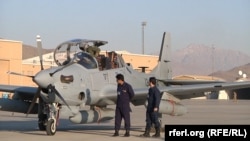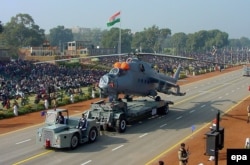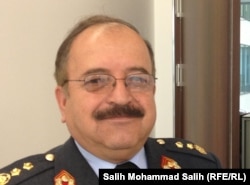PRAGUE, -- While serving as a fighter pilot for the Afghan communist regime's military in the 1980s, Abdul Wahab Wardak strafed the then Western-backed Islamic guerillas.
Today, as the head of the country's fledgling air force, the middle-aged lieutenant general is preparing to play a crucial role in preventing the Taliban spring offensive from grabbing territory or toppling the government he is serving.
"We have learned from our weaknesses and vulnerabilities," Wardak told Radio Mashaal. "We are better prepared."
Wardak says his 8,000-strong force is "ready to confront any threats" this year with more aircraft and improved overall capabilities.
Afghanistan relied on NATO's unchallenged dominance of Afghan air space after the demise of the Taliban regime in 2001. But after the end of NATO’s combat operations and the departure of most international troops by the end of 2014, the weaknesses of Afghanistan's nascent air force were exposed as it failed to provide combat and logistical support.
Wardak said last year was "very challenging" for his force because they were not ready to operate on their own after security responsibilities were handed over to Afghan forces from the U.S.-led international troops.
The situation now appears to be gradually improving. He said the Afghan Air Force will soon operate eight A-29 Super Tucano light attack aircraft donated by the United States. These will improve the Afghan military's counterinsurgency and close air support capabilities.
"These aircraft will help improve our firepower and targeting," he said. "This is because some of their munitions will be laser-guided."
Wardak said the recent acquisition of four Russian-made Mi-25 attack helicopters from India has already improved their operations in frontline provinces such as Helmand in the south and Kunduz in the north.
He said his forces have added rockets to Mi-70 helicopters, which has improved their effectiveness on the battlefield.
"Overall, we can now hit targets across Afghanistan day and night," he said. "We can protect our airfields and supplies and evacuate our forces."
The Afghan Air Force was once equipped with hundreds of mostly Soviet-made aircrafts in the 1980s but most of the equipment was lost during the anti-Soviet war in the 1980s and the subsequent civil war in the 1990s. The rehabilitation of the Afghan Air Force was slow after 2001.
But Wardak said his pilots and engineers are now being trained in the United States, the Czech Republic, the United Arab Emirates, India, China, Turkey, and Italy.
Wardak said that despite media reports regarding Russia’s willingness to help the Afghan Air Force, Kabul has so far received very little. "We are talking to the Russians, but we have not reached any agreement," he said.
The air force chief is all praise for Afghan President Ashraf Ghani, who he says is paying a lot of attention to building his force, which is vital to winning wars in his mountainous country.
"He is giving us his personal attention, which encourages me to say that the current year will be one of progress and growth for us," he said.
as/fg










